Dolphin/File Management/gl: Difference between revisions
Created page with "Esta aprendizaxe describe a versión de '''Dolphin''' incluída na versión 4 da colección de software de KDE. '''Konqueror''' era o xestor de ficheiros estándar nas versió..." |
Updating to match new version of source page |
||
| (40 intermediate revisions by 2 users not shown) | |||
| Line 1: | Line 1: | ||
<languages /> | <languages/> | ||
<span id="Discover Dolphin"></span> | <span id="Discover Dolphin"></span> | ||
= | <div class="mw-translate-fuzzy"> | ||
=== Dolphin ou Konqueror? === | === Dolphin ou Konqueror? === | ||
</div> | |||
<div class="mw-translate-fuzzy"> | |||
Esta aprendizaxe describe a versión de '''Dolphin''' incluída na versión 4 da colección de software de KDE. '''Konqueror''' era o xestor de ficheiros estándar nas versións 2 e 3 de KDE. Tamén pode usar '''Konqueror''' como xestor de ficheiros na versión 4 da colección de software de KDE: | Esta aprendizaxe describe a versión de '''Dolphin''' incluída na versión 4 da colección de software de KDE. '''Konqueror''' era o xestor de ficheiros estándar nas versións 2 e 3 de KDE. Tamén pode usar '''Konqueror''' como xestor de ficheiros na versión 4 da colección de software de KDE: | ||
# Abra a '''Configuración do sistema'''. | # Abra a '''Configuración do sistema'''. | ||
# Seleccione o módulo de <menuchoice>Programas predeterminados</menuchoice>. | # Seleccione o módulo de <menuchoice>Programas predeterminados</menuchoice>. | ||
# Seleccione '''Konqueror''' (ou calquera outro aplicativo) como xestor de ficheiros predeterminado. | # Seleccione '''Konqueror''' (ou calquera outro aplicativo) como xestor de ficheiros predeterminado. | ||
</div> | |||
[[Special:myLanguage/Konqueror|Konqueror]] was the default file manager in KDE 2 and 3, and is still available for those who prefer its interface. It is a web browser, a file manager, media viewer and more. For file management it uses the Dolphin KPart, and so has all of the functionality of Dolphin. | |||
'''Dolphin''' | <div class="mw-translate-fuzzy"> | ||
== Descubrir Dolphin == | |||
A primeira sección dá unha volta guiada por '''Dolphin'''. A segunda sección explica os conceptos dos distintos tipos de marcadores. A terceira sección fala sobre a xestión de arquivos. E finalmente, botámoslle unha ollada a «Outras cousas interesantes». Pode premer as imaxes para amplialas. | |||
</div> | |||
The first section takes you on a guided tour of '''Dolphin'''. The second section deals with the concepts of different types of bookmarks. The third section discusses archive management. Finally we look at 'More Cool Things'. The images are clickable - you can see the enlarged view. | |||
=== Introdución a Dolphin === | |||
'''Dolphin''' é o xestor de ficheiros da colección de software de KDE. | |||
A continuación explicarase como empregar '''Dolphin''' para tarefas habituais de xestión de ficheiros, e como personalizalo. | |||
[[Image:Dolphin_Plasma5_thumbnail.png|thumb|240px|center]] | |||
<div class="mw-translate-fuzzy"> | |||
Ao abrir '''Dolphin''' desde o [[Special:myLanguage/Plasma/Kickoff|menú Kickoff]], o xestor de ficheiros mostra o cartafol de inicio. O cartafol de inicio predeterminado é o [[Special:myLanguage/Glossary#Cartafol_persoal|cartafol persoal]]. | |||
</div> | |||
<div class="mw-translate-fuzzy"> | |||
Para abrir un ficheiro ou entrar nun cartafol, só ten que premer nel. Se prefire facer clic duplo, pode configuralo desde <menuchoice>Configuración do sistema -> Dispositivos de entrada -> Rato</menuchoice>. | |||
</div> | |||
Para seleccionar un ficheiro e cartafole, sitúa o cursor sobre el, e preme a cruz verde que aparecerá. Para deseleccionalo, repite os mesmos pasos; desta vez, a icona a premer será un guión vermello. Así: | |||
[[Image:Dolphin folder hover.png|thumb|240px|center]] | |||
Ao premer a icona de cruz, o ficheiro ou cartafol engadirase á selección. Para seleccionar varios ficheiros, só ten que repetir os pasos. Para seleccionar varios ficheiros, tamén pode premer o botón principal co cursor en calquera punto do panel central de '''Dolphin''', e arrastrar o cursor formando un rectángulo. | |||
Tamén pode usar atallos de teclado para seleccioan e deseleccionar ficheiros ou cartafoles: | |||
* Ao premer un ficheiro ou cartafol coa tecla <keycap>Ctrl</keycap> premida, o ficheiro ou cartafol selecciónase se non estaba seleccionado, e deselecciónase se estaba seleccionado. | |||
* Ao premer un ficheiro ou cartafol coa tecla <keycap>Maiús</keycap> premida, selecciónanse todos os ficheiros e cartafoles desde o último seleccionado ata o que acaba de premer. | |||
Así é como se ve cando se seleccionan varios ficheiros: | |||
[[Image:Dolphin folder hovered deselect.png|thumb|240px|center]] | [[Image:Dolphin folder hovered deselect.png|thumb|240px|center]] | ||
<div class="mw-translate-fuzzy"> | |||
'''Crear un cartafol novo'''. Para crear un cartafol novo dentro do cartafol actual, prema en calquera lugar do panel central para mostrar o menú contextual, e seleccione <menuchoice>Crear novo -> Cartafol</menuchoice>. Tamén pode usar o atallo <keycap>F10</keycap>. | |||
</div> | |||
''' | <div class="mw-translate-fuzzy"> | ||
''Lapelas''. '''Dolphin''' permite empregar lapelas. Para abrir unha nova lapela, seleccione <menuchoice>Ficheiro -> Nova lapela</menuchoice> (se ten a barra do menú activada). tamén pode empregar o atallo <keycap>Ctrl + T</keycap>, ou premendo co botón central no cartafol de destino ou botón de navegación. | |||
</div> | |||
<div class="mw-translate-fuzzy"> | |||
{{Note|A barra do menú de '''Dolphin''' está agochada, pero pode accederse a ela facilmente, así como facela visíbel de novo. Para activala, seleccione <menuchoice> Control -> Mostrar a barra de menú</menuchoice> ou prema <keycap>Ctrl + M</keycap>.}} | |||
</div> | |||
'''Dolphin''' ábrese de maneira predeterminada ao premer un cartafol. Tamén pode abrilo desde o [[Special:myLanguage/Plasma/Kickoff|menú Kickoff]]. | |||
== The Interface == | |||
== | <div class="mw-translate-fuzzy"> | ||
== Barra de lugar == | |||
</div> | |||
'''Dolphin''' | '''Dolphin''' introduce unha nova forma de usar a barra de lugar, máis rápida e precisa: unha barra de lugar en ronsel. En vez de mostrar a ruta completa, só se mostran os puntos de navegación, empezando desde un dos ''lugares'' do usuario, e cada punto de navegación é un botón. Ao premer un dos botóns, ábrese o cartafol ao que ese botón corresponde. Así pode acceder directamente a un cartafol desde calquera dos cartafoles e subcartafoles que hai dentro del. | ||
Entre os botóns que representan cartafoles hai frechas pequenas, que son á súa vez botón tamén. Ao premelas, pode ver unha lista dos cartafoles que están no mesmo nivel que o que está á dereita da frecha no ronsel, permitindo cambiar facilmente de cartafol. | |||
[[Image:Dolphin_nav.png|400px|thumb|center|Change directories quickly]] | [[Image:Dolphin_nav.png|400px|thumb|center|Change directories quickly]] | ||
<div class="mw-translate-fuzzy"> | |||
Tamén pode empregar unha barra de lugar clásica que mostra a ruta completa. Para iso, prema a barra de lugar co botón secundario e seleccione <menuchoice>Mostrar a ruta completa</menuchoice>. Se quere poder editar o lugar da barra, prema <keycap>Ctrl + L</keycap> ou seleccione <menuchoice> Control -> Barra de lugar -> Lugar editábel</menuchoice>. Se preme sobre o espazo baleiro que hai a continuación do último cartafol do ronsel da barra de lugar, tamén poderá editar a ruta da barra de lugar. Cando a barra de lugar está no modo de edición, móstrase unha marca no extremo dereito da barra. A marca é un botón que pode premer para devolver a barra de lugar ao modo de ronsel. Por suposto, tamén pode facer o mesmo mediante atallos de teclado ou mediante os menús. | |||
</div> | |||
<div class="mw-translate-fuzzy"> | |||
== Vista partida == | |||
</div> | |||
<div class="mw-translate-fuzzy"> | |||
'''Dolphin''' permite dividir a vista de cartafol en dúas, unha en cada lado, como en [[:wikipedia:Midnight Commander|Midnight Commander]]. Trátase dunha forma moi cómoda de copiar ficheiros dun cartafol a outro. | |||
</div> | |||
[[Image:Dolphin split view.png|thumb|350px|center]] | [[Image:Dolphin split view.png|thumb|350px|center]] | ||
Para dividir a vista, prema o botón <menuchoice>Dividir</menuchoice> da barra de ferramentas ou, se activou a barra do menú, seleccione <menuchoice>Vista -> Dividir</menuchoice> (o atallo de teclado é <keycap>F3</keycap>). Para volver á vista única, prema o botón <menuchoice>Pechar</menuchoice> ou prema <keycap>F3</keycap> de novo. A icona do botón indicará a xanela que se vai pechar. Segundo que vista estea activa, o guión (signo de restar) aparecerá á dereita ou á esquerda da icona. Pecharase a vista activa; é importante que non o esqueza se pensa empregar o atallo de teclado. Na barra de ferramentas hai tamén un botón para dividir e pechar a vista que mostra o guión tamén, polo que resulta doado identificar que vista se pechará. | |||
Por suposto, cada vista ten unha barra de lugar de seu, e pode usar un modo de vista diferente. | |||
=== Sorting Files === | |||
By default, the files in the currently displayed folder are sorted in ascending alphabetical order. However, this can be changed by selecting <menuchoice>Control</menuchoice> → <menuchoice>Sort by</menuchoice>. | |||
Files may be sorted by the following attributes | |||
* Name | * Name | ||
| Line 94: | Line 107: | ||
* Link Destination | * Link Destination | ||
* Path | * Path | ||
The sorting method can be changed by selecting <menuchoice>Sort by</menuchoice> from the toolbar and then select <menuchoice>A-Z</menuchoice> or <menuchoice>Z-A</menuchoice>. Additionally you may choose whether folders should be listed first by selecting <menuchoice>Folders First</menuchoice>. | |||
<div class="mw-translate-fuzzy"> | |||
== Modo de vista == | |||
</div> | |||
'''Dolphin''' features three different folder view modes: | |||
* {{Icon|breeze-dolphin-view-icons}} '''Icons''' shows each file or folder as an icon with its name | |||
* {{Icon|breeze-dolphin-view-compact}} '''Compact''' is the same as icons, but in a more compact form, allowing more folders and files to be displayed at once | |||
* {{Icon|breeze-dolphin-view-details}} '''Details''' presents a list of files and folders, giving information on each, including but not limited to size and date | |||
The mode can be changed from within Dolphin | |||
* Select <menuchoice>View Mode</menuchoice> from the <menuchoice>View</menuchoice> menu. This option is only available if the main Menubar is enabled | |||
* Select <menuchoice>View Mode</menuchoice> from the <menuchoice>Control</menuchoice> menu. This option is only available when the main Menubar is disabled | |||
* By selecting the appropriate icon from the main toolbar, if it is enabled | |||
* Using the default keyboard shortcuts: | |||
** <keycap>Ctrl+1</keycap> switches to the Icon display mode, | |||
** <keycap>Ctrl+2</keycap> switches to Compact and, | |||
** <keycap>Ctrl+3</keycap> switches to Detailed view. | |||
==== View as Icons ==== | |||
Each file and each folder is represented by an icon in this mode. Instead of displaying an icon a preview of the file can be shown. This feature can be turned on/off via the menu <menuchoice>View</menuchoice> → <menuchoice>Preview</menuchoice> (if menu bar is enabled) or via the main toolbar button <menuchoice>Preview</menuchoice>. | |||
There is the possibility to display additional information below the icons. These can be turned on/off via <menuchoice>Control</menuchoice> → <menuchoice>Additional Information</menuchoice> or <menuchoice>View</menuchoice> → <menuchoice>Additional Information</menuchoice> (if menu bar is enabled). In principal the same criteria which are available as search criteria can be selected. | |||
You can group the icons to achieve a better overview. This is turned on via <menuchoice>Control</menuchoice> → <menuchoice>Show in Groups</menuchoice> or <menuchoice>View</menuchoice> → <menuchoice>Show in Groups</menuchoice> (if menu bar is enabled). Now the icons are grouped and the groups are divided by a horizontal line containing the name of the group as caption. The grouping is related to the selected search criteria. | |||
[[Image:Dolphin show in groups effect.png|thumb|240px|center]] | [[Image:Dolphin show in groups effect.png|thumb|240px|center]] | ||
=== Details === | === Details === | ||
| Line 117: | Line 157: | ||
Column ''"Name''" is always displayed. By clicking on the header of one of the columns the table will be sorted by this column. By clicking on the same column header the sorting sequence is reversed. | Column ''"Name''" is always displayed. By clicking on the header of one of the columns the table will be sorted by this column. By clicking on the same column header the sorting sequence is reversed. | ||
It is possible to display the folders as a tree. In this mode a ''> symbol'' is shown next to the folder. By clicking on this sign the folder is expanded and all containing sub folders and files are also shown in the table but they are attenuated. By clicking the sign, which displays an ''arrow pointing downwards'', again the expansion is closed. Of course the tree structure can be used for as many folders as wished. In latest KDE releases, the tree view is enabled by default, but can be deactivated via <menuchoice>Control</menuchoice> → <menuchoice>Configure Dolphin</menuchoice> → <menuchoice>View Modes</menuchoice> → <menuchoice>Details</menuchoice> with option <menuchoice>Expandable Folders</menuchoice>. | |||
===Setting defaults for all folders=== | |||
Under <menuchoice>Control</menuchoice> → <menuchoice>Adjust View Properties</menuchoice> (or under the menu item <menuchoice>View</menuchoice> → <menuchoice>Adjust View Properties</menuchoice> if you have enabled menu bar) you can set any of these attributes to be the default for all folder views. | |||
Under <menuchoice>Control | |||
== Panels == | == Panels == | ||
'''Dolphin''' contains several panels, which can be activated via menu <menuchoice>Control | '''Dolphin''' contains several panels, which can be activated via menu <menuchoice>Control</menuchoice> → <menuchoice>Panels</menuchoice>. A panel can be placed in either the left or right docking area. To move a panel, ensure that panels are unlocked (right-click on a panel and select <menuchoice>Unlock Panels</menuchoice>). Then click on the header of the panel you want to move and drag it to the desired location. The new location of the panel is highlighted as you move the cursor around, before releasing the mouse button. Dropping a panel on top of another combines them into a tabbed view. | ||
In the header of each panel | In some versions of Dolphin, the header of each panel contains two buttons. The button near to the caption undocks the panel. This makes the panel an independent window which "floats" above '''Dolphin'''. The window is still combined with '''Dolphin''' and cannot be displayed without '''Dolphin''' and cannot for example be minimized like normal windows. By clicking the button again the panel is docked again. The second button closes the panel. | ||
=== Non Modal Dialogs === | === Non Modal Dialogs === | ||
| Line 136: | Line 174: | ||
When Moving, Copying or Deleting files/directories the dialog disappears even when the operation has not yet completed. A progress bar then appears in the bottom right of the screen, this then disappears also, if you want see the progress you need to click a small (i) information icon in the system tray. | When Moving, Copying or Deleting files/directories the dialog disappears even when the operation has not yet completed. A progress bar then appears in the bottom right of the screen, this then disappears also, if you want see the progress you need to click a small (i) information icon in the system tray. | ||
{{Warning| | {{Warning|New users who are not used to this way of working (and even experienced users) can get caught out by this, if you are Moving, Copying or Deleting large directories then you need to use the icon to monitor the progress of your operation. | ||
If you don't then any subsequent actions you do, may well use an incomplete file structure resulting in corrupted files. '''You have been warned!'''}} | |||
=== Places === | === Places === | ||
'''Dolphin''' contains a new kind of bookmarks ''Places''. These are displayed in a panel which can be activated via <menuchoice>Control | '''Dolphin''' contains a new kind of bookmarks ''Places''. These are displayed in a panel which can be activated via <menuchoice>Control</menuchoice> → <menuchoice>Panels</menuchoice> → <menuchoice>Places</menuchoice> (keyboard shortcut <keycap>F9</keycap>). The default Places are identical to the ones shown in the category ''Computer'' of the K-Menu [[Special:myLanguage/Plasma/Kickoff|Kickoff]]. | ||
By clicking one of these places it will be opened in the current folder view. The context menu offers the possibility to edit the places or to remove them again. It is also possible to hide entries temporarily. | By clicking one of these places it will be opened in the current folder view. The context menu offers the possibility to edit the places or to remove them again. It is also possible to hide entries temporarily. | ||
| Line 154: | Line 191: | ||
=== Information === | === Information === | ||
The information panel can be activated via <menuchoice>Control | The information panel can be activated via <menuchoice>Control</menuchoice> → <menuchoice>Show Panels</menuchoice> → <menuchoice>Information</menuchoice> (keyboard shortcut <keycap>F11</keycap>). This panel displays a preview or an icon of the currently selected file/folder or of the file/folder below the mouse cursor. Some additional information like change date or size to the file/folder is displayed as well. | ||
The information panel offers the possibility to rate files, add a comment or tag a file. This is one of the interfaces to the semantic Desktop [[Special:myLanguage/Nepomuk|Nepomuk]] which provides the advantages of the semantic web for the desktop. Starting from KDE 4.2 it is possible to search for the semantic links given by the tags. | The information panel offers the possibility to rate files, add a comment or tag a file. This is one of the interfaces to the semantic Desktop [[Special:myLanguage/Nepomuk|Nepomuk]] which provides the advantages of the semantic web for the desktop. Starting from KDE 4.2 it is possible to search for the semantic links given by the tags. | ||
[[Image:dolphin_panel.png|thumb|240px|center|The Information Panel]] | [[Image:dolphin_panel.png|thumb|240px|center|The Information Panel]] | ||
{{Tip|1=If you are wondering about missing mp3 ID tags (title, time ...) with some files it is most likely that ID3 Version 2 tags are missing. You can add ID3 version 2 tags with '''KID3''' for example.}} | {{Tip|1=If you are wondering about missing mp3 ID tags (title, time ...) with some files it is most likely that ID3 Version 2 tags are missing. You can add ID3 version 2 tags with '''KID3''' for example.}} | ||
| Line 166: | Line 201: | ||
=== Folders === | === Folders === | ||
A panel providing a tree structure for the file system can be displayed via <menuchoice>Control | A panel providing a tree structure for the file system can be displayed via <menuchoice>Control</menuchoice> → <menuchoice>Panels</menuchoice> → <menuchoice>Folders</menuchoice> (keyboard shortcut <keycap>F7</keycap>). The tree structure offers the possibility by clicking the > and ↓ signs to expand/collapse sub folders. By clicking on one of the folders the content will be displayed in the current view. | ||
=== Terminal === | === Terminal === | ||
The terminal emulator [[Special:myLanguage/Konsole|Konsole]] can be displayed directly in '''Dolphin''' via <menuchoice>Control | The terminal emulator [[Special:myLanguage/Konsole|Konsole]] can be displayed directly in '''Dolphin''' via <menuchoice>Control</menuchoice> → <menuchoice>Panels</menuchoice> → <menuchoice>Terminal</menuchoice> (keyboard shortcut <keycap>F4</keycap>). This makes it possible to use shell commands directly in '''Dolphin'''. The terminal is opened in the folder which is displayed in the current view. <keycap>Shift + F4</keycap> opens [[Special:myLanguage/Konsole|Konsole]] in new window. | ||
[[Image:dolphin_terminal.png|thumb|240px|center|Dolphin with a Terminal]] | [[Image:dolphin_terminal.png|thumb|240px|center|Dolphin with a Terminal]] | ||
==Bookmarks and Places== | ==Bookmarks and Places== | ||
KDE Plasma offers two different systems of user-based links to different locations in the file system. One is called ''Places'' and the other one is called ''Bookmarks''. They reside in different files, and have different functions. This offers more flexibility, however, it makes it necessary to learn the differences. | |||
[[Image:Konq3bookmarks.png|350px|thumb|center|KDE3 Konqueror didn't share bookmarks]] | [[Image:Konq3bookmarks.png|350px|thumb|center|KDE3 Konqueror didn't share bookmarks]] | ||
In contrast to the way '''Konqueror''' stored the bookmarks back in KDE3, both ''Places'' and ''Bookmarks'' are available to all applications as well as the '''Dolphin''' file manager. More of that later. | |||
=== | === Places in applications === | ||
=== | |||
====Places for system-wide navigation==== | |||
=== | |||
There is a default set of ''Places'' - | There is a default set of ''Places'' - | ||
| Line 227: | Line 238: | ||
You can see the result of that command if you read ~/. | You can see the result of that command if you read {{Path|~/.local/share/apps/kfileplaces/bookmarks.xml}}. | ||
In some applications too there is an option in the File menu to add a folder to Places. At this stage, however, applications vary in which features are available. The important thing to remember is that ''the default is for Places items to be available to all applications in the <menuchoice>File | In some applications too there is an option in the File menu to add a folder to Places. At this stage, however, applications vary in which features are available. The important thing to remember is that ''the default is for Places items to be available to all applications in the <menuchoice>File</menuchoice> → <menuchoice>Open</menuchoice> dialogue. '' | ||
====Constraining to one application==== | |||
Some applications allow you to edit items in the Places menu. For instance, if in [[Special:myLanguage/Gwenview|Gwenview]] you right click on a folder in Places you can set an option to <menuchoice>Only show when using this application (Gwenview)</menuchoice>. | |||
[[Image:OnlyShowIn2.png|350px|thumb|center|Constraining a bookmark to an application]] | |||
If you need to constrain to an application that does not yet allow you to do that, the only way left is to edit the file ~/.local/share/kfile/bookmarks.xml. Immediately before the </metadata> tag you will need to add the line {{Input|1= <OnlyInApp>appname</OnlyInApp>}} | |||
===Bookmarks in applications=== | |||
====Enable bookmarks==== | |||
Bookmarks are not enabled in dialogs by default. To enable them | |||
* Open the <menuchoice>File</menuchoice> menu and select <menuchoice>Open</menuchoice> or <menuchoice>Save</menuchoice> | |||
* Click the '''Options''' {{icon|breeze-configure}} icon | |||
* Select <menuchoice>Show Bookmarks</menuchoice> | |||
[[Image:EnablingBookmarks.png|350px|thumb|center|Enabling Bookmarks]] | |||
==== Using bookmarks ==== | |||
Bookmarks are the second class of user-based links to the file system. Remember opening <menuchoice>File</menuchoice> → <menuchoice>Open</menuchoice> and using the spanner/wrench? Next to it is a yellow star. This is the ''bookmark management menu''. | |||
[[Image:BookmarkManagement.png|350px|thumb|center|Manage Application bookmarks here]] | |||
Here you can define bookmarks that will be visible in the same menu on any application. They are stored in one file, {{Path|~/.local/share/kfile/bookmarks.xml}}, which is used by all applications having that menu. | |||
<span id="Archive Management in Dolphin"></span> | <span id="Archive Management in Dolphin"></span> | ||
===Archive Management in Dolphin=== | ===Archive Management in Dolphin=== | ||
Managing archives now becomes simple. In any directory in '''Dolphin''', highlight the files that you want to compress, and right-click. Here, using the Compress option, you can elect to create a RAR archive, a Gzipped tar archive, or define another compression mode that you have already set up. | Managing archives now becomes simple. In any directory in '''Dolphin''', highlight the files that you want to compress, and right-click. Here, using the Compress option, you can elect to create a RAR archive, a Gzipped tar archive, or define another compression mode that you have already set up. | ||
[[Image:Compress.png|350px|thumb|center|Create a new archive]] | [[Image:Compress.png|350px|thumb|center|Create a new archive]] | ||
Similarly, if you right-click on an existing archived file you get a range of actions added to the right-click menu. You can extract the archive to the current folder, to an autodetected subfolder or to another place of your choosing. | Similarly, if you right-click on an existing archived file you get a range of actions added to the right-click menu. You can extract the archive to the current folder, to an autodetected subfolder or to another place of your choosing. | ||
Should you wish to add files to an existing archive, you can choose <menuchoice>Open with Ark</menuchoice>. | Should you wish to add files to an existing archive, you can choose <menuchoice>Open with Ark</menuchoice>. | ||
[[Image:ManageArchives.png|350px|thumb|center|Manage existing archives]] | [[Image:ManageArchives.png|350px|thumb|center|Manage existing archives]] | ||
==More Cool Actions== | ==More Cool Actions== | ||
===Change a File Association on-the-fly=== | ===Change a File Association on-the-fly=== | ||
Have you ever wanted to open a file, only to find that it is [[Special:myLanguage/System_Settings/File_Associations|associated]] with an application that is not of your choice? | |||
You can, for one, alter this in <menuchoice>Kickoff</menuchoice> → <menuchoice>Computer</menuchoice> → <menuchoice>System Settings</menuchoice> → <menuchoice>Common Appearance and Behavior</menuchoice> → <menuchoice>File Associations</menuchoice>. This is the same as running '''kcmshell5 filetypes''' in a Konsole. | |||
Alternatively, if you want to change '''multiple''' associations right quick, you would edit the *.desktop file directly, e.g. the file {{Path|/usr/share/applications/org.gnome.Builder.desktop}}. For example, Gnome Builder associates with a great number of file-types which may not be desirable. So the line | |||
MimeType=application/javascript; # we do not want all of these .... | |||
may be shortened or commented out with # . Maybe a line | |||
InitialPreference=2 | |||
X-KDE-InitialPreference=3 | |||
in the builder.desktop file helps to keep your previous default associated app, with builder being only secondary or tertiary option. | |||
Thirdly, '''Dolphin''' and '''Konqueror''' offer a quick method for changing a '''single''' association: | |||
Right-click on the file and select <menuchoice>Properties</menuchoice>. The first line there is descriptive, something like: {{Output|1=Type: XML document}} | Right-click on the file and select <menuchoice>Properties</menuchoice>. The first line there is descriptive, something like: {{Output|1=Type: XML document}} | ||
| Line 280: | Line 311: | ||
===The Actions sub-menu=== | ===The Actions sub-menu=== | ||
The <menuchoice>Actions</menuchoice> sub-menu opens up a whole lot more cool things to do from '''Dolphin'''. Some possibilities only appear when applicable to the file you have selected. Some of the options are | The <menuchoice>Actions</menuchoice> sub-menu opens up a whole lot more cool things to do from '''Dolphin'''. Some possibilities only appear when applicable to the file you have selected. An apps .desktop file below {{Path|/usr/share/applications}} defines what actions are applicable for a particular type of file. Some of the options are | ||
* Convert an image file to a different format | * Convert an image file to a different format | ||
* Preview the file | * Preview the file | ||
| Line 290: | Line 321: | ||
* Insert an audio CD | * Insert an audio CD | ||
* Navigate to this CD in '''Dolphin''': it must appear as "Volume" in your '''Dolphin''' 'Places' or you can reach it by typing audiocd:/ in the address bar. | * Navigate to this CD in '''Dolphin''': it must appear as "Volume" in your '''Dolphin''' 'Places' or you can reach it by typing audiocd:/ in the address bar. | ||
[[Image:Cdaudiodolphin.jpeg|550px|thumb|center|Dolphin presenting audio CD]] | [[Image:Cdaudiodolphin.jpeg|550px|thumb|center|Dolphin presenting audio CD]] | ||
You now notice that '''Dolphin''' is proposing a WAV file for each track, plus: | You now notice that '''Dolphin''' is proposing a WAV file for each track, plus: | ||
| Line 305: | Line 334: | ||
You then just have to copy the folder of your choice, in your preferred format to obtain the relative encoded version of your CD! | You then just have to copy the folder of your choice, in your preferred format to obtain the relative encoded version of your CD! | ||
=== Using <tt>timeline</tt> to have your recent files as startup folder === | |||
=== | |||
[[File:Recent.jpg|400px|thumb|right|Have your recent files always in Dolphin]] | [[File:Recent.jpg|400px|thumb|right|Have your recent files always in Dolphin]] | ||
''' | You can start up dolphin (with '''baloo''' up and running) with a view of ''recently modified files'': Just navigate to the address/location of <tt>timeline:/today/</tt> (copy paste it to the address bar) or use it as '''dolphin start-up-folder''' in dolphin-settings. | ||
== External links == | |||
* [http://en.wikipedia.org/wiki/Dolphin_(software) Wikipedia- Dolphin_(software)] | |||
* [http://dot.kde.org/1172721427/ Road to KDE 4: Dolphin and Konqueror] | |||
* [http://arstechnica.com/news.ars/post/20070405-afirst-look-at-dolphin-the-kde-4-file-manager.html Ars Technica: A First Look at Dolphin] | |||
* [http://introducingkde4.blogspot.com/2007/12/dolphin.html Introducing KDE 4 Blog - Dolphin] | |||
< | <div class="mw-translate-fuzzy"> | ||
[[Category:Dolphin/gl]] | [[Category:Dolphin/gl]] | ||
[[Category:Aprendizaxes/gl]] | [[Category:Aprendizaxes/gl]] | ||
[[Category:Xestión de ficheiros/gl]] | [[Category:Xestión de ficheiros/gl]] | ||
[[Category:KDE3/gl]] | [[Category:KDE3/gl]] | ||
</ | </div> | ||
Latest revision as of 17:11, 23 June 2021
Dolphin ou Konqueror?
Esta aprendizaxe describe a versión de Dolphin incluída na versión 4 da colección de software de KDE. Konqueror era o xestor de ficheiros estándar nas versións 2 e 3 de KDE. Tamén pode usar Konqueror como xestor de ficheiros na versión 4 da colección de software de KDE:
- Abra a Configuración do sistema.
- Seleccione o módulo de .
- Seleccione Konqueror (ou calquera outro aplicativo) como xestor de ficheiros predeterminado.
Konqueror was the default file manager in KDE 2 and 3, and is still available for those who prefer its interface. It is a web browser, a file manager, media viewer and more. For file management it uses the Dolphin KPart, and so has all of the functionality of Dolphin.
Descubrir Dolphin
A primeira sección dá unha volta guiada por Dolphin. A segunda sección explica os conceptos dos distintos tipos de marcadores. A terceira sección fala sobre a xestión de arquivos. E finalmente, botámoslle unha ollada a «Outras cousas interesantes». Pode premer as imaxes para amplialas.
The first section takes you on a guided tour of Dolphin. The second section deals with the concepts of different types of bookmarks. The third section discusses archive management. Finally we look at 'More Cool Things'. The images are clickable - you can see the enlarged view.
Introdución a Dolphin
Dolphin é o xestor de ficheiros da colección de software de KDE.
A continuación explicarase como empregar Dolphin para tarefas habituais de xestión de ficheiros, e como personalizalo.
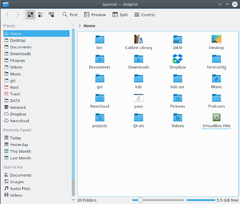
Ao abrir Dolphin desde o menú Kickoff, o xestor de ficheiros mostra o cartafol de inicio. O cartafol de inicio predeterminado é o cartafol persoal.
Para abrir un ficheiro ou entrar nun cartafol, só ten que premer nel. Se prefire facer clic duplo, pode configuralo desde .
Para seleccionar un ficheiro e cartafole, sitúa o cursor sobre el, e preme a cruz verde que aparecerá. Para deseleccionalo, repite os mesmos pasos; desta vez, a icona a premer será un guión vermello. Así:
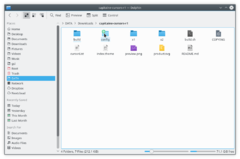
Ao premer a icona de cruz, o ficheiro ou cartafol engadirase á selección. Para seleccionar varios ficheiros, só ten que repetir os pasos. Para seleccionar varios ficheiros, tamén pode premer o botón principal co cursor en calquera punto do panel central de Dolphin, e arrastrar o cursor formando un rectángulo.
Tamén pode usar atallos de teclado para seleccioan e deseleccionar ficheiros ou cartafoles:
- Ao premer un ficheiro ou cartafol coa tecla Ctrl premida, o ficheiro ou cartafol selecciónase se non estaba seleccionado, e deselecciónase se estaba seleccionado.
- Ao premer un ficheiro ou cartafol coa tecla Maiús premida, selecciónanse todos os ficheiros e cartafoles desde o último seleccionado ata o que acaba de premer.
Así é como se ve cando se seleccionan varios ficheiros:

Crear un cartafol novo. Para crear un cartafol novo dentro do cartafol actual, prema en calquera lugar do panel central para mostrar o menú contextual, e seleccione . Tamén pode usar o atallo F10.
Lapelas. Dolphin permite empregar lapelas. Para abrir unha nova lapela, seleccione (se ten a barra do menú activada). tamén pode empregar o atallo Ctrl + T, ou premendo co botón central no cartafol de destino ou botón de navegación.
Dolphin ábrese de maneira predeterminada ao premer un cartafol. Tamén pode abrilo desde o menú Kickoff.
The Interface
Barra de lugar
Dolphin introduce unha nova forma de usar a barra de lugar, máis rápida e precisa: unha barra de lugar en ronsel. En vez de mostrar a ruta completa, só se mostran os puntos de navegación, empezando desde un dos lugares do usuario, e cada punto de navegación é un botón. Ao premer un dos botóns, ábrese o cartafol ao que ese botón corresponde. Así pode acceder directamente a un cartafol desde calquera dos cartafoles e subcartafoles que hai dentro del.
Entre os botóns que representan cartafoles hai frechas pequenas, que son á súa vez botón tamén. Ao premelas, pode ver unha lista dos cartafoles que están no mesmo nivel que o que está á dereita da frecha no ronsel, permitindo cambiar facilmente de cartafol.
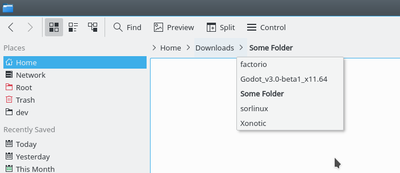
Tamén pode empregar unha barra de lugar clásica que mostra a ruta completa. Para iso, prema a barra de lugar co botón secundario e seleccione . Se quere poder editar o lugar da barra, prema Ctrl + L ou seleccione . Se preme sobre o espazo baleiro que hai a continuación do último cartafol do ronsel da barra de lugar, tamén poderá editar a ruta da barra de lugar. Cando a barra de lugar está no modo de edición, móstrase unha marca no extremo dereito da barra. A marca é un botón que pode premer para devolver a barra de lugar ao modo de ronsel. Por suposto, tamén pode facer o mesmo mediante atallos de teclado ou mediante os menús.
Vista partida
Dolphin permite dividir a vista de cartafol en dúas, unha en cada lado, como en Midnight Commander. Trátase dunha forma moi cómoda de copiar ficheiros dun cartafol a outro.
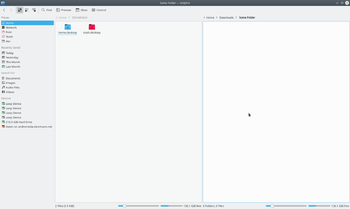
Para dividir a vista, prema o botón da barra de ferramentas ou, se activou a barra do menú, seleccione (o atallo de teclado é F3). Para volver á vista única, prema o botón ou prema F3 de novo. A icona do botón indicará a xanela que se vai pechar. Segundo que vista estea activa, o guión (signo de restar) aparecerá á dereita ou á esquerda da icona. Pecharase a vista activa; é importante que non o esqueza se pensa empregar o atallo de teclado. Na barra de ferramentas hai tamén un botón para dividir e pechar a vista que mostra o guión tamén, polo que resulta doado identificar que vista se pechará.
Por suposto, cada vista ten unha barra de lugar de seu, e pode usar un modo de vista diferente.
Sorting Files
By default, the files in the currently displayed folder are sorted in ascending alphabetical order. However, this can be changed by selecting → .
Files may be sorted by the following attributes
- Name
- Size
- Date
- Permissions
- Owner
- Group
- Type
- Link Destination
- Path
The sorting method can be changed by selecting from the toolbar and then select or . Additionally you may choose whether folders should be listed first by selecting .
Modo de vista
Dolphin features three different folder view modes:
 Icons shows each file or folder as an icon with its name
Icons shows each file or folder as an icon with its name
 Compact is the same as icons, but in a more compact form, allowing more folders and files to be displayed at once
Compact is the same as icons, but in a more compact form, allowing more folders and files to be displayed at once
 Details presents a list of files and folders, giving information on each, including but not limited to size and date
Details presents a list of files and folders, giving information on each, including but not limited to size and date
The mode can be changed from within Dolphin
- Select from the menu. This option is only available if the main Menubar is enabled
- Select from the menu. This option is only available when the main Menubar is disabled
- By selecting the appropriate icon from the main toolbar, if it is enabled
- Using the default keyboard shortcuts:
- Ctrl+1 switches to the Icon display mode,
- Ctrl+2 switches to Compact and,
- Ctrl+3 switches to Detailed view.
View as Icons
Each file and each folder is represented by an icon in this mode. Instead of displaying an icon a preview of the file can be shown. This feature can be turned on/off via the menu → (if menu bar is enabled) or via the main toolbar button .
There is the possibility to display additional information below the icons. These can be turned on/off via → or → (if menu bar is enabled). In principal the same criteria which are available as search criteria can be selected.
You can group the icons to achieve a better overview. This is turned on via → or → (if menu bar is enabled). Now the icons are grouped and the groups are divided by a horizontal line containing the name of the group as caption. The grouping is related to the selected search criteria.
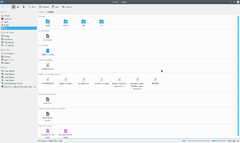
Details
In view mode "Details" additional information is displayed by default in contrast to view mode "Icons". All files are listed in a tabular. The context menu of the table header offers the possibility to add additional columns. The following columns are available:
- Size
- Date
- Permissions
- Owner
- Group
- Type
- Link Destination
- Path
Column "Name" is always displayed. By clicking on the header of one of the columns the table will be sorted by this column. By clicking on the same column header the sorting sequence is reversed.
It is possible to display the folders as a tree. In this mode a > symbol is shown next to the folder. By clicking on this sign the folder is expanded and all containing sub folders and files are also shown in the table but they are attenuated. By clicking the sign, which displays an arrow pointing downwards, again the expansion is closed. Of course the tree structure can be used for as many folders as wished. In latest KDE releases, the tree view is enabled by default, but can be deactivated via → → → with option .
Setting defaults for all folders
Under → (or under the menu item → if you have enabled menu bar) you can set any of these attributes to be the default for all folder views.
Panels
Dolphin contains several panels, which can be activated via menu → . A panel can be placed in either the left or right docking area. To move a panel, ensure that panels are unlocked (right-click on a panel and select ). Then click on the header of the panel you want to move and drag it to the desired location. The new location of the panel is highlighted as you move the cursor around, before releasing the mouse button. Dropping a panel on top of another combines them into a tabbed view.
In some versions of Dolphin, the header of each panel contains two buttons. The button near to the caption undocks the panel. This makes the panel an independent window which "floats" above Dolphin. The window is still combined with Dolphin and cannot be displayed without Dolphin and cannot for example be minimized like normal windows. By clicking the button again the panel is docked again. The second button closes the panel.
Non Modal Dialogs
When Moving, Copying or Deleting files/directories the dialog disappears even when the operation has not yet completed. A progress bar then appears in the bottom right of the screen, this then disappears also, if you want see the progress you need to click a small (i) information icon in the system tray.
Places
Dolphin contains a new kind of bookmarks Places. These are displayed in a panel which can be activated via → → (keyboard shortcut F9). The default Places are identical to the ones shown in the category Computer of the K-Menu Kickoff.
By clicking one of these places it will be opened in the current folder view. The context menu offers the possibility to edit the places or to remove them again. It is also possible to hide entries temporarily.
The context menu of a folder can be used to add this folder an another entry to the Places panel. Therefore there is a menu item . You can also Drag&Drop a folder to the Places panel.
The places panel also contains entries to connected removable devices like USB-keys or CDs. A small plug icon indicates if the device is mounted. The context menu offers the possibility to unmount the device.
The places are used as the basis in the breadcrumb navigation bar. Each address is shown in relation to the nearest parent folder which is one of the places.
Information
The information panel can be activated via → → (keyboard shortcut F11). This panel displays a preview or an icon of the currently selected file/folder or of the file/folder below the mouse cursor. Some additional information like change date or size to the file/folder is displayed as well.
The information panel offers the possibility to rate files, add a comment or tag a file. This is one of the interfaces to the semantic Desktop Nepomuk which provides the advantages of the semantic web for the desktop. Starting from KDE 4.2 it is possible to search for the semantic links given by the tags.
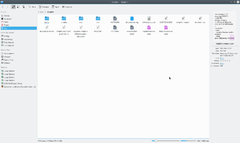
Folders
A panel providing a tree structure for the file system can be displayed via → → (keyboard shortcut F7). The tree structure offers the possibility by clicking the > and ↓ signs to expand/collapse sub folders. By clicking on one of the folders the content will be displayed in the current view.
Terminal
The terminal emulator Konsole can be displayed directly in Dolphin via → → (keyboard shortcut F4). This makes it possible to use shell commands directly in Dolphin. The terminal is opened in the folder which is displayed in the current view. Shift + F4 opens Konsole in new window.
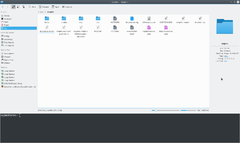
Bookmarks and Places
KDE Plasma offers two different systems of user-based links to different locations in the file system. One is called Places and the other one is called Bookmarks. They reside in different files, and have different functions. This offers more flexibility, however, it makes it necessary to learn the differences.
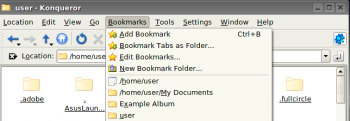
In contrast to the way Konqueror stored the bookmarks back in KDE3, both Places and Bookmarks are available to all applications as well as the Dolphin file manager. More of that later.
Places in applications
There is a default set of Places -
- Home
- Network
- Root
- Trash
but you can add other places. In Dolphin, right-click on a folder and select , or just drag a folder onto Places.
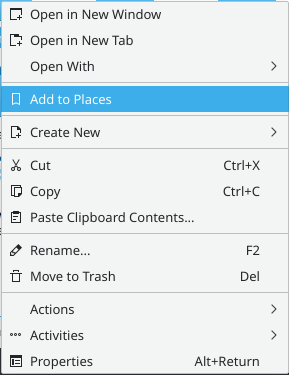
By default this "Place" will be visible in all applications. If you want to keep it constrained to Dolphin, you need to right-click on the new name in the Places list, where you will find the option to Edit it. There is a check-box for .
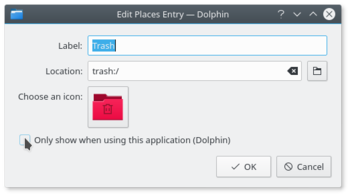
You can see the result of that command if you read ~/.local/share/apps/kfileplaces/bookmarks.xml.
In some applications too there is an option in the File menu to add a folder to Places. At this stage, however, applications vary in which features are available. The important thing to remember is that the default is for Places items to be available to all applications in the → dialogue.
Constraining to one application
Some applications allow you to edit items in the Places menu. For instance, if in Gwenview you right click on a folder in Places you can set an option to .
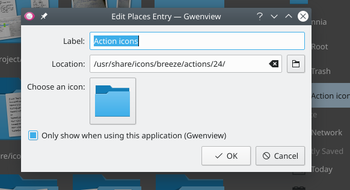
If you need to constrain to an application that does not yet allow you to do that, the only way left is to edit the file ~/.local/share/kfile/bookmarks.xml. Immediately before the </metadata> tag you will need to add the line
<OnlyInApp>appname</OnlyInApp>
Bookmarks in applications
Enable bookmarks
Bookmarks are not enabled in dialogs by default. To enable them
- Open the menu and select or
- Click the Options
 icon
icon - Select
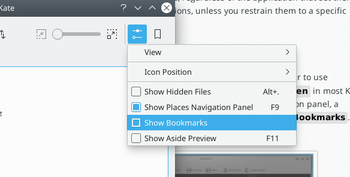
Using bookmarks
Bookmarks are the second class of user-based links to the file system. Remember opening → and using the spanner/wrench? Next to it is a yellow star. This is the bookmark management menu.
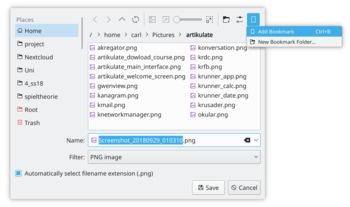
Here you can define bookmarks that will be visible in the same menu on any application. They are stored in one file, ~/.local/share/kfile/bookmarks.xml, which is used by all applications having that menu.
Archive Management in Dolphin
Managing archives now becomes simple. In any directory in Dolphin, highlight the files that you want to compress, and right-click. Here, using the Compress option, you can elect to create a RAR archive, a Gzipped tar archive, or define another compression mode that you have already set up.
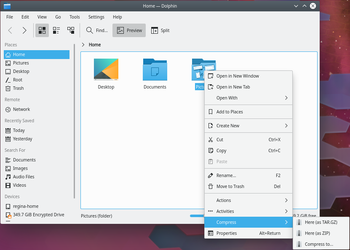
Similarly, if you right-click on an existing archived file you get a range of actions added to the right-click menu. You can extract the archive to the current folder, to an autodetected subfolder or to another place of your choosing.
Should you wish to add files to an existing archive, you can choose .
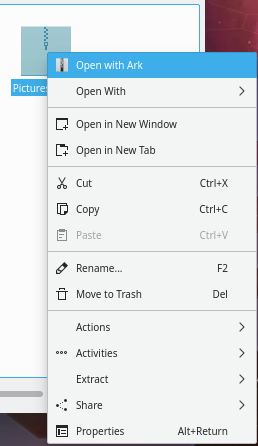
More Cool Actions
Change a File Association on-the-fly
Have you ever wanted to open a file, only to find that it is associated with an application that is not of your choice?
You can, for one, alter this in → → → → . This is the same as running kcmshell5 filetypes in a Konsole.
Alternatively, if you want to change multiple associations right quick, you would edit the *.desktop file directly, e.g. the file /usr/share/applications/org.gnome.Builder.desktop. For example, Gnome Builder associates with a great number of file-types which may not be desirable. So the line
MimeType=application/javascript; # we do not want all of these ....
may be shortened or commented out with # . Maybe a line
InitialPreference=2 X-KDE-InitialPreference=3
in the builder.desktop file helps to keep your previous default associated app, with builder being only secondary or tertiary option.
Thirdly, Dolphin and Konqueror offer a quick method for changing a single association:
Right-click on the file and select . The first line there is descriptive, something like:
Type: XML document
At the same level, on the right, there is a spanner (wrench). Click on that and you can add or change an association.
Similarly, by working on a folder, you can change the default file manager to/from Konqueror, if you choose, or add another image browser to the possible associations.
The sub-menu opens up a whole lot more cool things to do from Dolphin. Some possibilities only appear when applicable to the file you have selected. An apps .desktop file below /usr/share/applications defines what actions are applicable for a particular type of file. Some of the options are
- Convert an image file to a different format
- Preview the file
- Download a remote file with KGet
- Sign and/or encrypt the file, according to the encryption software installed
Encode and copy audio CD tracks
- Insert an audio CD
- Navigate to this CD in Dolphin: it must appear as "Volume" in your Dolphin 'Places' or you can reach it by typing audiocd:/ in the address bar.
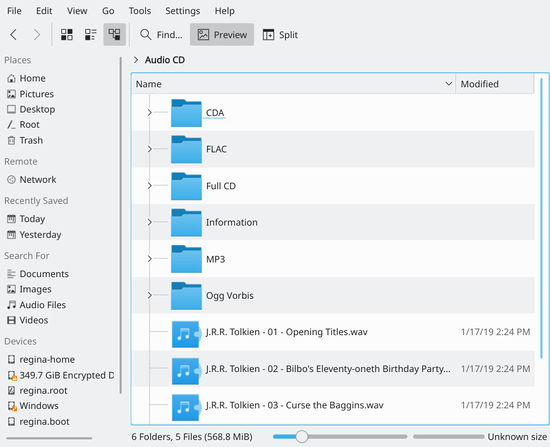
You now notice that Dolphin is proposing a WAV file for each track, plus:
- a CDA folder containing indexing information in the usual CDA format.
- a Whole CD folder, containing one file for each format (.cda, .flac, .mp3, .ogg, .wav) holding all the tracks
- a FLAC folder, containing the tracks encoded into FLAC format (lossless information format)
- an Information folder containing the CDDB informations
- an MP3 folder, containing all the tracks in MP3 format
- a Ogg Vorbis folder, containing the tracks encoded in OGG format
You then just have to copy the folder of your choice, in your preferred format to obtain the relative encoded version of your CD!
Using timeline to have your recent files as startup folder
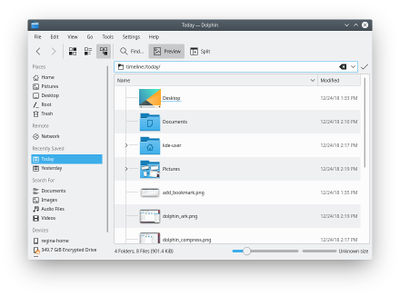
You can start up dolphin (with baloo up and running) with a view of recently modified files: Just navigate to the address/location of timeline:/today/ (copy paste it to the address bar) or use it as dolphin start-up-folder in dolphin-settings.



